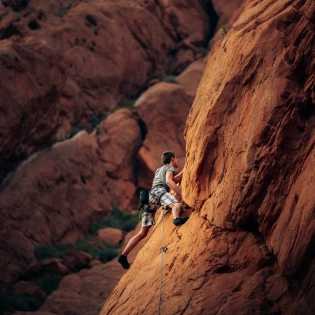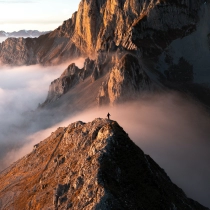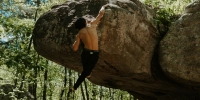

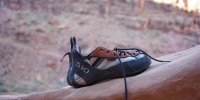
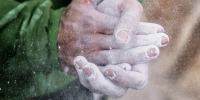


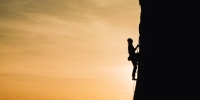
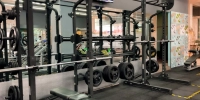
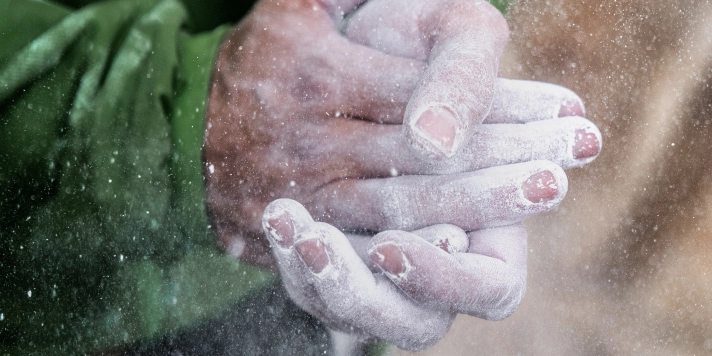
general climbing
It is worth eating after climbing, but it really depends on the time you spent climbing and at what level of effort you climbed at.
If you spent most of the session sitting or just not climbing, eating right after may not be that important, and you could probably just eat awhile after.
If you feel you spent a lot of energy while climbing and are drained, it may be better to eat after.
It also really depends on your diet. Many people train and climb while fasting, so they would only eat when their next meal is scheduled.
In general, if you are not on any specific diet or regime, you can eat right after or wait a while, it is up to you. If you feel weak, faint, or drained, then you just may want to eat something sooner than later.
Bouldering.
Boulders are the short routes that require crash pads if climbing outdoors. Indoor gyms have certain types of mattresses for falling on.
Rock climbing on higher walls without gear, including a rope and harness, is called free solo. It is the most dangerous form of climbing as you are climbing above safe heights with no protection.
You actually don't need prior upper body strength to start climbing. You will gain that strength as you climb.
Many people believe that to climb, you need to pull your whole body's weight with your arms, essentially doing pull-ups to get to the top of the route. This, though, is very far from the truth.
Think of rock climbing as climbing a ladder. You would not just pull yourself up a ladder with your hands, right? No, you would use your legs to push yourself up, and your hands to slightly pull, but mainly to balance/navigate yourself. The same logic applies to climbing, especially in the easier routes.
Beginner climbing routes tend to have large holds that are easy to grab on to and hold. These routes are essentially ladders, they usually go straight up. All you need to do is to climb them just like you would a ladder. Their purpose is to slowly get people used to the feeling of climbing, the shoes, and the holds. As the routes get harder, the holds get smaller and harder to hold, and the routes get technically and physically harder.
By the time you get to those harder routes, though, you will have built up the upper and lower body strength that would allow you to climb them. But for the easier routes, and for beginner climbers, you can just start climbing without worrying about having prior upper or lower body strength.
Rock climbing is one of the best sports for building grip strength, and also one of the fastest to show improvements.
The main muscles used in climbing are the forearms, which are the muscles used for gripping.
While different grips do use different muscles, climbing is a great overall grip strengthener.
Beginner climbers will probably see the greatest improvements to their grip strength as it will work muscles that normally are not used at the level that climbing utilizes them, and not in the same way.
As you get more experience and go up in the climbing difficulty grades, your grip will also strengthen. The more advanced routes require more grip and hand strength, so as long as you are climbing and progressing, your grip and hand strength should also be increasing.
On top of that, climbers also tend to do extra exercises for their grip and fingers to help them go up the grades quicker and easier, and to improve their overall grip and hand strength. These additional exercises allow climbers to exercise specific grip styles, such as a more open hand grip, or a more closed hand grip. They also allow for different muscles in the forearms to be trained in a more isolated way.
Here are some exercises and tools climbers use to help strengthen their hands and grip:
- Hangboarding - Probably the most well known and common way of training fingers, hangboards usually have different edges with different depths and is used by just hanging from them from your fingertips. The smaller the edge, the more difficult it is. There are many exercises that can be done on the hang board, some with body weight, and some with weights, but they should all be done with caution as it is very easy to injure yourself on hangboards. Most people would say that you should not hangboard until you have climbed for at least 1 year, that is to make sure that your fingers and tendons are strong enough to actually handle the load hangboarding has on them.
- Pinch blocks - A great way to train grip strength for those small and large pinch holds on the wall, and a great general forearm strengthener, is the pinch block. This exercise uses a block, usually made of wood, and some weights that are attached to the bottom of it by a rope. All you do is punch the block and lift it for a few seconds off of the ground (depending on the exercise), and lower it back down.
- Crimp blocks - A sort of hybrid between the hangboard and the pinch block. This too is usually made of wood, and weights are attached to it. Just like the pinch block, depending on the exercise, you would grip this block with your fingertips, lift, hold, and then lower again. This exercise, much like the hangboard, needs to be done with a lot of caution as you can easily injure your fingers with this one too.
- Dead hangs - Probably the easiest and most available to do, all you need is a pull-up bar, or something to hang from, and then you just hang from it for as long as you can. You can add weight as you progress also.
- Finger curls using barbells or dumbbells - Not as common as the others, but still an option if you have some weight available to you. Don't add too much weight though as it could cause finger injuries.
Even without the additional exercises, though, climbing on its own is one of the best sports for increasing grip strength, maybe even the best, due to its heavy use of the fingers and forearms.
Firstly, something many people don't actually realize is that the shoulders play a huge role in climbing. Many people think that climbing mainly uses your arms, back, and core, and that all of the other muscles are more like "supporters" for those main muscles.
Shoulders are heavily used in climbing, they are constantly engaged, and just as with other muscles, if you over use your shoulder muscles, they will hurt. If your shoulder muscles are generally weak, they will be more likely to hurt more than other muscles.
On top of that, climbing puts your body and shoulders in positions it may not be used to, causing your shoulders to put in extra effort in keeping your body stabilized and on the wall.
While climbing, our hands are mostly above our heads, or at head-height. This position, in addition to the heavy load they must bear (sometimes your body weight is held largely with the help of your shoulders), can cause a lot of strain on your shoulders, especially in the overhead position which can cause pinching to occur, resulting in painful shoulders.
With time and with better technique and stronger shoulders, the pain felt in the shoulders should lessen. This does of course depend on how well you listen to your body and if you give it the correct amount of rest which it requires. If not, you will likely injure yourself much soon and much worse.
If the pain is serious, and you are having a difficult time with it even when not climbing, you should see a doctor to get it checked. I have had a lot of issues with my shoulders in the past due to previous unrelated injuries, and climbing actually amplified the pain until I started treating it better and resting better. Now, my shoulders have gotten much stronger and I feel almost no pain at all. So listening to your body is crucial.

